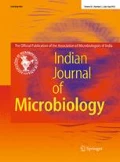Abstract
L-asparaginases are extensively applied in the treatment of Acute Lymphoblastic Leukemia (ALL). The treatment regime of ALL consists of asparaginase from E. coli or Erwinia. The survival rate post-chemotherapy has increased to < 90% in recent years. Asparaginase therapy has also resulted in numerous toxicities to patients receiving therapy. This study demonstrates the reaction of normal cells of Danio rerio to asparaginase therapy. L-asparaginase I and II used in the present study are from two probiotic Lactobacillus species in comparison with a commercial L-asparaginase of E. coli origin. Zebrafish adults were injected with 2500 U/kg body weight of L-asparaginase treatments. The expression of SOD 2, CAT, GST, GTP BP3, FADS2 were analyzed with EF1α as house-keeping gene. The p value obtained proves that the data are significant. The histology of the L-asparaginase I treated fishes showed dilated sinusoids in the liver and pseudocyst in the pancreas. The L-asparaginase II and commercial asparaginase showed no pathology.


References
Oliveira M, Sampaio KC, Oliveira AC, Santos AD, Castro LP, Viana MB (2015) Outcome of children and adolescents with lymphoblastic lymphoma. Rev Assoc Med Bras 61:417–422. https://doi.org/10.1590/1806-9282.61.05.417
Brumano LP, da Silva FVS, Costa-Silva TA, Apolinário AC, Santos JHPM, Kleingesinds EK, Monteiro G, Rangel-Yagui CdO, Benyahia B, Junior AP (2019) Development of L-asparaginase biobetters: current research status and review of the desirable quality profiles. Front Bioeng Biotechnol 6:212. https://doi.org/10.3389/fbioe.2018.00212
Egler RA, Sanjay AP, Yousif M (2016) L-asparaginase in the treatment of patients with acute lymphoblastic leukemia. J Pharmacol Pharmacother 7:62–71. https://doi.org/10.4103/0976-500X.184769
Nadeem MS, Al-Ghamdi MA, Khan JA (2019) Studies on the recombinant production in E.coli and characterization of pharmaceutically important thermostable L-asparaginase from Geobacillus thermodenitrificans. Pak J Zoo 51:1235–1241. https://doi.org/10.17582/journal.pjz/2019.51.4.1235.1241
Ebrahiminezhad A, Rasoul-Amini S, Ghasemi Y (2011) l-Asparaginase production by moderate halophilic bacteria isolated from Maharloo salt lake. Indian J Microbiol 51:307–311. https://doi.org/10.1007/s12088-011-0158-6
Sivakumar K, Sahu MK, Thangaradjou T, Kannan L (2007) Research on marine actinobacteria in India. Indian J Microbiol 47:186–196. https://doi.org/10.1007/s12088-007-0039-1
Ghasemian A, Al-marzoqi AH, Al-abodi HR (2019) Bacterial L-asparaginases for cancer therapy: current knowledge and future perspectives. J Cell Physiol 1:9. https://doi.org/10.1002/jcp.28563
Hijiya N, van der Sluis IM (2016) Asparaginase associated toxicity in children with acute lymphoblastic leukemia. Leuk Lymphoma 57:748–757. https://doi.org/10.3109/10428194.2015.1101098
Schmiegelow K, Attarbaschi A, Barzilai S, Escherich G et al (2016) Consensus definitions of 14 severe acute toxic effects for childhood lymphoblastic leukaemia treatment: a Delphi consensus. Lancet Oncol 17:e231–e239. https://doi.org/10.1016/S1470-2045(16)30035-3
Susan Aishwarya S, Iyappan S, Vijaya Lakshmi K, Rajnish KN (2017) In silico analysis, molecular cloning, expression and characterization of L-asparaginase gene from Lactobacillus reuteri DSM 20016. 3 Biotech 7:348. https://doi.org/10.1007/s13205-017-0974-4
Aishwarya SS, Selvarajan E, Iyappan S, Rajnish KN (2019) Recombinant L -asparaginase II from Lactobacillus casei subsp casei ATCC 393 and its anti-cancer properties. Indian J Microbiol 59:313–320. https://doi.org/10.1007/s12088-019-00806-0
Kaufman MB (2013) 2012 American society of health-system pharmacists midyear clinical meeting & exhibition. P T 38:119–120
Kinkel MD, Eames SC, Philipson LH, Prince VE (2010) Intraperitoneal injection into adult zebrafish. J Vis Exp 42:e2126. https://doi.org/10.3791/2126
Lewis RJ Sr (2005) Sax’s dangerous properties of industrial materials, eleventh ed. Hoboken. J Am Chem Soc 127:2794. https://doi.org/10.1021/ja041002c
Fernandez CA, Smith C, Karol SE, Ramsey LB, Liu C, Pui C, Jeha S, Evans WE, Finkelman FD, Relling MV (2015) Effect of remedications in a murine model of asparaginase hypersensitivity. J Pharmacol Exp Ther 352:541–551. https://doi.org/10.1124/jpet.114.220780
Horvath TD, Chan WK, Pontikos MA, Martin LA, Du D, Tan L, Konopleva M, Weinstein JN, Lorenzi PL (2019) Assessment of L-asparaginase pharmacodynamics in mouse models of cancer. Metabolites 9:10. https://doi.org/10.3390/metabo9010010
Tang R, Dodd A, Lai D, Mcnabb WC, Love DR (2007) Validation of zebrafish (Danio rerio) reference genes for quantitative Real-time RT-PCR normalization. Acta Biochim Biophy Sin 39:384–390. https://doi.org/10.1111/j.1745-7270.2007.00283.x
Liu C, Janke LJ, Kawedia JD, Ramsey LB, Cai X, Mattano LA Jr, Boyd KL, Funk AJ, Relling MV (2016) Asparaginase potentiates glucocorticoid-induced osteonecrosis in a mouse model. PLoS ONE 11:e0151433. https://doi.org/10.1371/journal.pone.0151433
Nogami-Hara A, Hara K, Kawakami Y, Shimada A, Mio M (2016) L-Asparaginase-induced allergy in mice: effects of concomitant drugs and anti-IgE antibody. Blood 128:1632. https://doi.org/10.1182/blood.V128.22.1632.1632
Acknowledgements
The authors thank Dr. S. Iyappan, Dr. S. Kirankumar and research scholars of Zebrafish genetics lab for their help and support. Authors thank the SRM-DBT Partnership Platform for Contemporary Research Services and Skill Development in Advanced Life Sciences Technologies (No. BT/PR12987/INF/22/205/2015) for providing the RT-PCR facility. The authors thank Dr. Usha Rani Ravikumar, Professor, and Head of Pathology, Velammal Medical College for analyzing the histology slides.
Author information
Authors and Affiliations
Corresponding authors
Ethics declarations
Conflict of interest
The authors have no conflict of interest to declare.
Additional information
Publisher's Note
Springer Nature remains neutral with regard to jurisdictional claims in published maps and institutional affiliations.
Electronic Supplementary Material
Below is the link to the electronic supplementary material.
Rights and permissions
About this article
Cite this article
Suresh, S.A., Ethiraj, S. & Rajnish, K.N. Toxicity Analysis of Recombinant L-asparaginase I and II in Zebrafish. Indian J Microbiol 60, 535–538 (2020). https://doi.org/10.1007/s12088-020-00890-7
Received:
Accepted:
Published:
Issue Date:
DOI: https://doi.org/10.1007/s12088-020-00890-7

